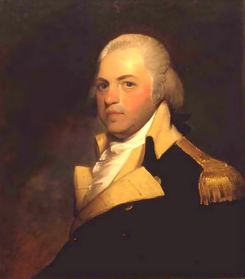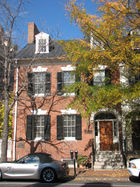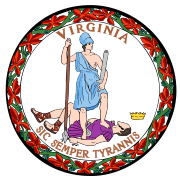Henry Lee III
| Henry Lee III | |
 |
|
|
9th Governor of Virginia
|
|
|---|---|
| In office 1791–1794 |
|
| Preceded by | Beverley Randolph |
| Succeeded by | Robert Brooke |
|
Member of the U.S. House of Representatives from Virginia's 19th district
|
|
| In office 1799–1800 |
|
| Preceded by | Walter Jones |
| Succeeded by | John Talifierro |
|
|
|
| Born | January 29, 1756 Dumfries, Virginia, British America |
| Died | March 25, 1818 (aged 62) Cumberland Island, Georgia, United States |
| Resting place | Lee Chapel Washington and Lee University Lexington, Virginia |
| Political party | Federalist |
| Spouse(s) | Matilda Ludwell Lee Anne Hill Carter |
| Alma mater | College of New Jersey |
| Signature | |
| Military service | |
| Service/branch | Continental Army United States Army |
| Rank | Lieutenant Colonel Major General |
| Battles/wars | American Revolutionary War Whiskey Rebellion |
Henry Lee III (29 January 1756 – 25 March 1818) was an early American patriot who served as the ninth Governor of Virginia and as the Virginia Representative to the United States Congress. During the American Revolution, Lee served as a cavalry officer in the Continental Army and earned the name Light-Horse Harry[1][2]. He was also the father of Confederate general Robert E. Lee.
Contents |
Life and career
Lee was born near Dumfries, Virginia, the son of Henry Lee II (1730–1787) of "Leesylvania" and Lucy Grymes (1734–1792) the "Lowland Beauty." His father was the second cousin of Richard Henry Lee, sixth President of the Continental Congress. His mother was an aunt of the wife of Virginia Governor Thomas Nelson Jr. His great-grandmother Mary Bland was a great-aunt of President Thomas Jefferson and he descended once from King John of England, twice from King Edward I of England, once from King Jean de Brienne of Jerusalem, twice from King Edward III of England and once from King Pedro I of Castile.[3][4]
Military career
Lee graduated from the College of New Jersey (now Princeton University) in 1773, and began pursuing a legal career. With the outbreak of the Revolutionary War, he became a Captain in a Virginia dragoon detachment, which was attached to the 1st Continental Light Dragoons. In 1778, Lee was promoted to Major and given the command of a mixed corps of cavalry and infantry known as Lee's Legion, with which he won a great reputation as a leader of light troops.
It was during his time as commander of the Legion that Lee earned the sobriquet of "Light-Horse Harry" for his horsemanship. On September 22, 1779 the Continental Congress voted to present Lee with a gold medal–a reward given to no other officer below a general's rank– for the Legion's actions during the Battle of Paulus Hook in New Jersey, on 19 August of that year.[5][6]
Lee was promoted to Lieutenant Colonel and was assigned with his Legion to the southern theater of war. Lee's forces served at the Battle of Guilford Court House, the Battle of Camden and the Battle of Eutaw Springs. He was present at Cornwallis's surrender at Yorktown, but left the Army shortly after due to an illness. During the infamous Whiskey Rebellion, Lee commanded the 13,000 militiamen sent to quash the rebels.
Marriages and children
Between 8-13 April 1782, at "Stratford Hall", Lee married his second-cousin, Matilda Ludwell Lee (1764-1790), who was known as "The Divine Matilda". Matilda was the daughter of the Hon. Philip Ludwell Lee, Sr., Esq. and Elizabeth Steptoe. Matilda had three children before she died in 1790;
- Philip Lee (1784-1794)
- Lucy Lee (1786-1860)
- Henry Lee IV (28 May 1787 — 30 January 1837), was a historian and author who also served as a speech writer for both John C. Calhoun and presidential candidate Andrew Jackson, also helping the latter to write his inaugural address.
On 13 June 1793, Lee married the wealthy Anne Hill Carter (1773-1829) at Shirley Plantation. Anne was the daughter of Charles Carter, Esq., of Shirley, and his wife Ann Butler Moore. She was also a descendant of King Robert II of Scotland through the 2nd Earls of Crawford.[7] They had six children, the eldest died unnamed in infancy in 1796;
- Unnamed Infant (1796-1796)
- Charles Carter Lee (1798-1871)
- Anne Kinloch Lee (1800-1864)
- Sydney Smith Lee (1802-1869)
- Robert Edward Lee (19 January 1807 — 12 October 1870), the fifth child of Henry and Anne, served as a Confederate general during the American Civil War.
- Mildred Lee (1811-1856)
Politics
From 1786 to 1788, Lee was a delegate to the Continental Congress, and in the last-named year in the Virginia convention, he favored the adoption of the United States Constitution. From 1789 to 1791, he served in the General Assembly and, from 1791 to 1794, was Governor of Virginia.
In 1794, Lee accompanied Washington to help the suppression of the Whiskey Rebellion in western Pennsylvania. A new county of Virginia was named after him during his governorship. Henry Lee was a major general in the U.S. Army in 1798–1800. From 1799 to 1801, he served in the United States House of Representatives of the Congress. He famously eulogized Washington to a crowd of 4,000 at the first President's funeral on December 26, 1799 [8]—"first in war, first in peace, and first in the hearts of his countrymen."
The Panic of 1796-1797 and bankruptcy of Robert Morris reduced Lee's fortune. When Robert E. was two, his father served one year in debtor's prison in Montross, Virginia.[9][10]

Death
On 27 July 1812, Lee received grave injuries while helping to resist an attack on his friend, Alexander Contee Hanson, editor of the Baltimore newspaper, The Federal Republican. Hanson was attacked by Democratic-Republican mob because his paper opposed the War of 1812. Lee and Hanson and two dozen other Federalists had taken refuge in the offices of the paper. The group surrendered to Baltimore city officials the next day and were jailed. Laborer George Woolslager led a mob that forced its way into the jail and removed and beat the Federalists over the next three hours. One Federalist, James Lingan, died.
Lee suffered extensive internal injuries as well as head and face wounds, and even his speech was affected. Lee later sailed to the West Indies in an effort to recuperate from his injuries. He died on 25 March 1818, at Dungeness, on Cumberland Island, Georgia.
Lee was buried with full military honors provided by an American fleet stationed near St. Marys. In 1913 his remains were removed to the Lee family crypt at Lee Chapel, on the campus of Washington & Lee University in Lexington, Virginia.[11]
In popular culture
In the film The Patriot, it is thought that the character Colonel Harry Burwell is loosely based on Lee.
Published works
- Lee, Henry, and Robert E. Lee. Memoirs of the War in the Southern Department of the United States. Eyewitness accounts of the American Revolution. [New York]: New York times, 1969. (originally published 1812; 3rd ed. published in 1869, with memoir by his son Robert E. Lee)
See also
- Light Horse Tavern
References
- ↑ In the military parlance of the time, the term "Light-horse" had a hyphen between the two words "light" and "horse". See the title page of "The Discipline of the Light-Horse" by Captain Robert Hinde of the Royal Regiment of Foresters (Light-Dragoons) published in London in 1778.
- ↑ Hinde, Captain Robert (1778), Discipline of the Light-Horse, London: W.Owen, http://books.google.com/books?id=jB5EAAAAYAAJ&printsec=frontcover#v=onepage&q&f=false, retrieved 20 August 2010
- ↑ "Ancestors of Henry III LEE". Whosyomama.com. 2005-02-01. http://www.whosyomama.com/gabroaddrick3/4/27743.htm. Retrieved 2010-08-10.
- ↑ [1]
- ↑ The medal (which is actually silver) finally presented to Lee is in Princeton University’s Numismatic Collection. Also included are a signed letter of Lee's to the New Jersey quartermaster from 1780 and a signed letter of the same year from George Washington to Lee approving Lee’s plan to capture Benedict Arnold.
- ↑ Discovery of medal that Congress granted to Lee
- ↑ Fontaine, William W. The Descent Of General Robert Edward Lee From Robert The Bruce, Of Scotland. www.civilwarhome.com. Retrieved 13 October 2008.
- ↑ "Papers of George Washington". Gwpapers.virginia.edu. http://gwpapers.virginia.edu/project/exhibit/mourning/response.html. Retrieved 2010-08-10.
- ↑ A Princeton Companion(Lee, Henry), 1978, http://etcweb.princeton.edu/CampusWWW/Companion/lee_henry.html, retrieved 20 August 2010
- ↑ Stratford Hall/Lee Family Tree: Henry Lee III, http://etcweb.princeton.edu/CampusWWW/Companion/lee_henry.html, retrieved 20 August 2010
- ↑ AmericanHeritage.com / Private Fastness: TALES OF WILD
 Chisholm, Hugh, ed (1911). "Lee, Henry". Encyclopædia Britannica (Eleventh ed.). Cambridge University Press.
Chisholm, Hugh, ed (1911). "Lee, Henry". Encyclopædia Britannica (Eleventh ed.). Cambridge University Press.
External links
- Henry Lee III at the Biographical Directory of the United States Congress Retrieved on 2008-07-02
- Baltimore Riot of 1812
| Political offices | ||
|---|---|---|
| Preceded by Beverley Randolph |
Governor of Virginia 1791–1794 |
Succeeded by Robert Brooke |
| United States House of Representatives | ||
| Preceded by Walter Jones |
Member of the U.S. House of Representatives from Virginia's 19th congressional district 4 March 1799–3 March 1801 (obsolete district) |
Succeeded by Edwin Gray |
|
|||||||
